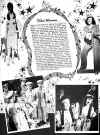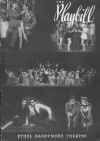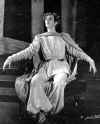History of the Musical Stage
1940s: Just Before "Mornin"
by John Kenrick
(Copyright 1996; revised 2014)
(The images below are thumbnails – click on them to see larger versions.)
State of the Art, Circa 1940
 Ethel Merman is profiled in the
souvenir program for Cole Porter's nonsensical hit Something for the Boys (1943).
Ethel Merman is profiled in the
souvenir program for Cole Porter's nonsensical hit Something for the Boys (1943).
With the world at war and America still suffering echoes of the Great Depression, most Broadway professionals felt that audiences of the early 1940s wanted an escape from reality, the more lighthearted the better. For example, Irving Berlin had reigned as America's most popular composer since 1911, contributing hit songs to numerous stage reviews and films. The 1940s brought his first book musical to Broadway -- Louisiana Purchase (1940 - 444 performances) a comic send-up of corrupt Louisiana politics co-starring the popular team of William Gaxton and Victor Moore.
After America entered World War II, Berlin triumphed again with This is the Army (1942 - 113 performances), a revue with an all-Army cast poking lighthearted fun at the trials of military life. Musical highlights included "I Left My Heart at the Stage Door Canteen." Berlin himself performed "Oh, How I Hate to Get Up in the Morning," which he had introduced in the World War I fundraiser Yip, Yip, Yapank (1918 - 32 performances). After an extended Broadway run, This is the Army toured the US, had a hit London run, and was made into a popular film, eventually earning over $9 million for the Army's Emergency Relief Fund.
In the early 1940s, musical comedy master Cole Porter continued his long-running streak of hits, with four shows that racked up impressive runs –
Panama Hattie (1940 - 501 performances) starred Ethel Merman as a brassy Canal Zone bar owner who tries to polish up her act when she falls in love with a Philadelphia socialite. Merman and eight year old Joan Carroll shared "Let's Be Buddies." Hattie marked Merman's first time as a solo star, and it became the first Broadway musical to top 500 performances since the 1920s.
Let's Face It (1941 - 547 performances) featured Eve Arden and Danny Kaye in a tale of three wealthy wives who get revenge on their cheating husbands by taking on three soldiers as gigolos. The score included "Let's Not Talk About Love" and "You Irritate Me So." Wartime audiences were delighted, and Porter had another show top the 500 performance mark.
Something For the Boys (1943 - 422 performances) is the perfect example of what most musical comedies tried to be in the early 1940s, relying on a major star, an unlikely plot situation, and a few wacky comic twists. Ethel Merman played a wartime factory worker who inherits property adjacent to a military base in Texas. While there, she falls in love with a bandleader/soldier and finds that her dental fillings pick up radio signals. (Believe it or not, some dental filings did pick up low frequency radio transmissions.) This silliness gave Merman plenty of comic moments and Porter songs (including "Hey Good Lookin'" and the suggestive title tune) to belt in her trademark style. Not great art, but it packed the Imperial Theatre for more than a year.
As the 1940s began, great art was not the goal in musical theatre. Most producers and critics were convinced that good songs and good fun were all that theatergoers required. As had happened before and would happen again, the experts were underestimating the ticket-buying public.
Signs of Change
A few people were determined to make the Broadway musical grow up, and their innovative efforts snuck in right alongside the traditional fluff. Composer Vernon Duke and lyricist John LaTouche offered Cabin In The Sky (1940 - 156 performances), the parable of an angel and a demon in a tug of war for a black man's soul. The fine score (including "Taking a Chance On Love") was integrated with the book, but the show had a limited appeal. The superb 1943 MGM film version had a similar fate -- rave reviews, weak box office response.
 Gene
Kelly, Vivienne Segal and members of the ensemble on the original cast Playbill for
Pal Joey.
Gene
Kelly, Vivienne Segal and members of the ensemble on the original cast Playbill for
Pal Joey.
Richard Rodgers and Lorenz Hart took some creative risks with Pal Joey (1940 - 374 performances), Broadway's first musical to center on an anti-hero. The title character is a sleazy nightclub hoofer who hustles his way to success by manipulating a wealthy mistress, only to lose everything when she comes to her senses and dumps him. The score ranged from the innocent romance of "I Could Write A Book" to the sexual bite of "Bewitched, Bothered and Bewildered." Newcomer Gene Kelly played the title character, with Vivienne Segal as his mistress and June Havoc (vaudeville's former "Baby June") as one of the nightclub showgirls. Of course, it helped that veteran director George Abbott was on hand to pull all these elements together. Though most critics objected to Pal Joey's seamy subject matter, it ran for a profitable year. Many of the same critics would praise the show when it was revived in 1952.
Ira Gershwin withdrew from songwriting for several years after his brother George's death in 1937. He returned in style by teaming with composer Kurt Weill and playwright Moss Hart to create Lady in the Dark (1941 - 467 performances), the story of a magazine editor who uses psychoanalysis to explore her romantic insecurities. The music was restricted to several dream sequences in which the main character saw herself at events representing her inner turmoil -- a party, a trial, and a circus. Newcomer Danny Kaye's winning performance as an effeminate fashion photographer (and his lightning fast delivery of the patter song "Tschaikowsky") made him an immediate star, but even he could not steal the show from Gertrude Lawrence. With the ballad "My Ship" and the show-stopping "Jenny," this masterful stage star kept audiences cheering for the longest run of her career.
"The result was a stunning blend of all components of the theatre. According to published reports, the production involved a company of 58 performers, 51 stagehands, and 4 revolving stages. It was mounted for the then staggering cost $130,000."
- Stanley Richards, Great Musicals of the American Theatre, Vol. 2, (Radnor, PA: Chilton Books, 1976), p. 74.
An Ending and a Beginning
 Ray
Bolger as Sapiens, the emasculated husband of an
Amazon warrior in Rodgers and Hart's longest running stage hit, By Jupiter.
Ray
Bolger as Sapiens, the emasculated husband of an
Amazon warrior in Rodgers and Hart's longest running stage hit, By Jupiter.
Rodgers and Hart took a lighter turn with By Jupiter (1942 - 427 performances), which told of a conflict between ancient Greeks and female Amazon warriors. Hilarious role reversals between men and women ("You swear like a longshorewoman!") stretched the creative boundaries. A stellar performance by Ray Bolger and a score that included "Wait Till You See Her" made this Rodgers & Hart's longest running show. It was also the last new score they would collaborate on.
Torn by personal demons, including shame over his homosexuality, Hart had become a hopeless alcoholic. His talents were intact, but he would disappear on drinking binges for days and even weeks at a time, making it impossible for him to reliably contribute to new projects. An anxious Rodgers asked his longtime partner to dry out and work with him on a musical adaptation of Lynn Rigg's unsuccessful play Green Grow the Lilacs. This was a last-hope project for the Theatre Guild, which had given Rodgers and Hart their first big break, and was now drowning in debt. When Hart rejected the idea of putting singing cowboys on a Broadway stage, Rodgers warned that he was ready to collaborate with Oscar Hammerstein II. Hart encouraged Rodgers to pursue the new partnership, then headed off to Mexico for a drinking spree.
Rodgers got busy with Hammerstein, who had been interested in adapting Green Grow the Lilacs for several years (his longtime collaborator Jerome Kern had rejected the project). Thus began the most renowned creative partnership the American musical theatre has ever known. As their own song put it, "They couldn't pick a better time to start . . ."
